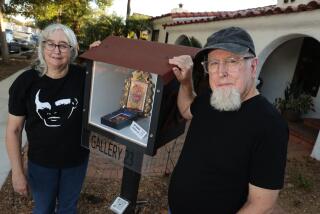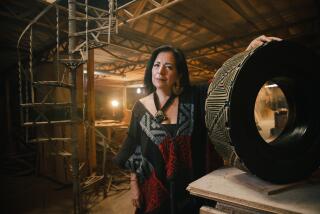The Kindness of Strangers
Imagine that you are a well-educated, experienced artist. You have shown your work in prestigious places, achieved considerable recognition and influenced many students with your teaching, but you still remain in the art world’s shadows and you can’t make a living from the work you do in your studio. One day, out of the blue, you receive a phone call from New York saying you have won a $25,000 grant from a secretive organization you didn’t know existed. What do you do?
* Burst into tears?
* Call your mother?
* Fear you dreamed the whole thing?
* Decide you are the victim of a cruel joke?
* Question your sanity?
Los Angeles-based painter Robin Mitchell had all those reactions when she heard she was one of 10 winners in the first round of awards given by a new grants program called Anonymous Was a Woman. After she stopped crying and got a night’s sleep, she called grant administrator Lauren Katzowitz for reassurance that the phone call the preceding day hadn’t been a hoax.
Now persuaded that a check for $25,000 really will be in the mail at the end of the year, the 44-year-old artist said she is “overjoyed, flattered and proud.”
*
So are two other Southern Californians, installation artist Kim Yasuda and video artist Gina Lamb, who are among the 1996 awardees. Other winners are: sculptors Jeanne Silverthorne and Lynne Yamamoto, both of New York; photographers Shellburne Thurber of Boston and Deborah Willis of Washington; installation artists Rachel Berwick of New Haven, Conn., and Claudia Matzko of Shaker Heights, Ohio; and Lucy Winer, a film and video maker from New York.
“It’s an affirmation of my work,” Mitchell said of the unexpected grant, “and it couldn’t have come at a better time. My career is growing and my work is growing like crazy, but I’ve been teaching for 20 years and teaching jobs are drying up.” Other sources of income for artists--including gallery sales and grants from public and private sources--also have dwindled in the last few years, she said.
Anonymous Was a Woman recognizes that fact. The program, which plans annually to give $25,000 grants to 10 female visual artists over 30 years of age, was established in response to the elimination of fellowships by the National Endowment for the Arts, said Katzowitz, who administers the grants through Foundation Service, a New York management organization for private foundations.
The name, Anonymous Was a Woman, comes from a line in Virginia Woolf’s book “A Room of One’s Own,” which deals with women’s need for an independent income and a private space in order to pursue creativity. And, indeed, almost everything about the program is anonymous. Katzowitz declined to name the donor or donors. She said the artists were nominated by female curators, writers and art historians across the country, but declined to name them or say how many people are involved in the process. Applications are not accepted, she said.
“The people involved have personal reasons for remaining anonymous,” Katzowitz said, “but that was not meant to be a factor in the program. The intent is to focus on the artists. What I can tell you, from a personal point of view, is that this has been a rich experience, just hearing about the impact the grants will have on the artists’ lives.”
After notifying each winner by phone, she sent a letter of congratulations and explanation: “The award is given in recognition of your exceptional creativity and promise and is intended to provide meaningful assistance at a critical juncture in your career. The award is unrestricted, to enable you to utilize your talents and abilities freely and as you see fit. There are no requirements or obligations of any kind, except that you are asked to submit a letter at the end of the year telling us of any difference the award made in your life or work. The award may be received only once.”
*
Asked how she would use the money, Mitchell’s first response was: “Now I can get the oil changed in my car.” Small emergencies aside, the significance of the grant is that it “buys time” to concentrate on her painting, she said.
Gina Lamb, 37, agreed that time is the biggest bonus. “I’ve been doing collaborative work for a long time,” she said. “This will give me a chance to work in my studio and edit some tapes that are on my shelf. Also, I’m at a point where I want to take some time off from teaching. Now I can have a little hiatus.” Lamb, who teaches at Pitzer College in Claremont, plans to take a semester off.
She also has been an artist-in-residence at Jefferson High School in Los Angeles, where she has made about 100 videotapes with youth during the last nine years. The program has been financed by various sources--including Los Angeles’ Cultural Affairs Department, the California Arts Council, the NEA and the Andy Warhol Foundation--and the tapes have been widely distributed at video festivals and even on Japanese television. But Lamb doesn’t have a grant to continue the program this year. “I’m in a transitional period,” she said. “I think it’s time to move on, and this grant will help me do that.”
For Kim Yasuda, 36, who has a tenured teaching position at UC Santa Barbara, the grant is “more than an economic thing, it reaffirms what I’ve been doing. I don’t make money from my work, but this is an affirmation of all the years of pouring money into it.”
Known both for intimate interior installations and public art projects--including bus shelter pavilions designed for the Gateway Transit Center at Union Station--she said the grant came at a pivotal moment, when she hopes to work out new ways of combining art, architecture and film. She will use the money for research and reflection, possibly to pay for tuition at an East Coast institution during an upcoming sabbatical.
Receiving the award shocked all three artists, but Yasuda said the shroud of anonymity is a plus. “I’m still reeling, but I think it’s great that I didn’t know about it and didn’t apply for it.” Unlike many other grants, “it’s not a matter of who you know,” she said.
More to Read
The biggest entertainment stories
Get our big stories about Hollywood, film, television, music, arts, culture and more right in your inbox as soon as they publish.
You may occasionally receive promotional content from the Los Angeles Times.










